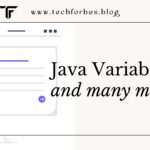Introduction
Java is one of the most versatile and powerful programming languages in the world. However, its true potential shines when combined with other technologies. From web applications to AI-driven systems, Java plays a key role in shaping modern software solutions.
In this blog, we’ll explore how Java, when paired with Angular, React, Python, MySQL, IoT, and more, powers cutting-edge innovations.
1. Java + Angular = Web Applications 🌐
Java and Angular together form a robust tech stack for building high-performance web applications. Java provides a scalable backend, while Angular ensures a dynamic, interactive frontend. This combination is widely used in enterprise-level applications.
🔹 Use Case: Online banking portals, e-commerce platforms
2. Java + React = Modern UI/UX Apps 🎨
React’s component-based UI framework combined with Java’s backend capabilities helps in building interactive, fast, and seamless applications. This combination is widely used in single-page applications (SPAs).
🔹 Use Case: Social media platforms, dashboards
3. Java + Python = AI-Powered Solutions 🤖
Python is a leader in AI and machine learning, while Java is known for its performance and scalability. Together, they help in building AI-driven applications that can process big data efficiently.
🔹 Use Case: Chatbots, predictive analytics, AI-powered recommendation engines
4. Java + MySQL = Data-Driven Applications 💾
Databases are the backbone of modern applications. Java’s integration with MySQL enables secure and efficient data management, making it ideal for building scalable data-driven apps.
🔹 Use Case: CRM systems, inventory management
5. Java + IoT = Smart Devices & Automation 🤖🏠
Java is a platform-independent language, making it perfect for Internet of Things (IoT) applications. When paired with IoT, Java powers smart devices, home automation, and industrial solutions.
🔹 Use Case: Smart homes, industrial automation systems
6. Java + Spring Boot + Microservices = Scalable Cloud Apps ☁️
Spring Boot simplifies Java application development, while microservices architecture helps create scalable cloud-based applications. This combination is ideal for businesses moving to the cloud.
🔹 Use Case: SaaS products, enterprise applications
7. Java + Apache Kafka = Real-Time Data Processing ⚡
For applications requiring high-speed, real-time data processing, Java with Apache Kafka is the go-to choice. Kafka enables efficient message streaming for handling large-scale data.
🔹 Use Case: Fraud detection systems, stock trading platforms
8. Java + Android = Mobile Applications 📱
Java is the official language for Android development. Combining Java with Android SDK allows developers to build fast, responsive, and scalable mobile applications.
🔹 Use Case: E-learning apps, fitness trackers, finance apps
9. Java + Docker + Kubernetes = Cloud-Native Apps ☁️🔗
Cloud-native applications require containerization for deployment and scalability. Java with Docker and Kubernetes makes it easier to manage microservices and cloud deployments.
🔹 Use Case: Cloud-hosted AI applications, serverless computing
Conclusion
Java’s strength lies in its ability to seamlessly integrate with other technologies. Whether it’s AI, IoT, cloud computing, web development, or real-time data processing, Java remains at the forefront of technological advancements.
💡 Which Java combination excites you the most? Share your thoughts in the comments!

